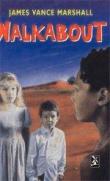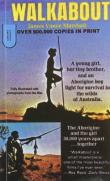AustLit
Latest Issues
AbstractHistoryArchive Description
'A plane crashes in the vast Northern Territory of Australia, and the only survivors are two children from Charleston, South Carolina, on their way to visit their uncle in Adelaide. Mary and her younger brother, Peter, set out on foot, lost in the vast, hot Australian outback. They are saved by a chance meeting with an unnamed Aboriginal boy on walkabout. He looks after the two strange white children and shows them how to find food and water in the wilderness, and yet, for all that, Mary is filled with distrust.
'On the surface Walkabout is an adventure story, but darker themes lie beneath. Peter's innocent friendship with the boy met in the desert throws into relief Mary's half-adult anxieties, and the book as a whole raises questions about what is lost—and may be saved—when different worlds meet. And in reading Marshall's extraordinary evocations of the beautiful yet forbidding landscape of the Australian desert, perhaps the most striking presence of all in this small, perfect book, we realize that this tale—a deep yet disturbing story in the spirit of Adalbert Stifter's Rock Crystal and Richard Hughes's A High Wind in Jamaica—is also a reckoning with the mysteriously regenerative powers of death' (publisher blurb, NYRB Classics).'
Adaptations
-
form
y
 Walkabout
( dir. Nicholas Roeg
)
Australia
:
Max L. Raab - Si Litvinoff Film Productions
,
1971
Z1039037
1971
single work
film/TV
(taught in 6 units)
Walkabout
( dir. Nicholas Roeg
)
Australia
:
Max L. Raab - Si Litvinoff Film Productions
,
1971
Z1039037
1971
single work
film/TV
(taught in 6 units)
Adapted from James Vance Marshall's novel The Children, Walkabout begins with a father-of-two driving his fourteen-year-old daughter and six-year-old son into the desert. Overwhelmed by the pressure on his life, he plans to kill them and then commit suicide, but his plan goes wrong. The siblings wander the desert aimlessly until they meet a young Aboriginal boy who is on a solitary walkabout as part of his tribal initiation into manhood. The three become travelling companions. Gradually, sexual tension develops between the girl and the Aboriginal boy. When they approach white civilisation, the Aboriginal boy dances a night-long courtship dance, but the girl is ignorant of its meaning. When she and her brother awake in the morning, they find the boy dead, hanging from a tree. The brother and sister make their way to the nearby mining town, where they receive a cool welcome from the townsfolk.
Notes
-
This novel, though published under the name James Vance Marshall, was actually written by the English author Donald Gordon Payne and was based on the notes of Marshall. Marshall claimed the work as his own during his lifetime and is likely to have written the initial draft of the work. Following Marshall's death, Payne (who claims this work as his own) continued to publish novels for children and adults using Marshall's name. This was done with the family's permission and in some cases the later books also drew on Marshall's notes. There has been confusion about the status of the works in numerous sources.
Publication Details of Only Known VersionEarliest 2 Known Versions of
Other Formats
- Also braille, large print, sound recording.
Works about this Work
-
Genocide and Ecocide
2020
single work
criticism
— Appears in: Packing Death in Australian Literature : Ecocides and Eco-Sides 2020; (p. 21-43) -
The Aboriginal Trauma Narrative and Roeg's Walkabout
2017
single work
criticism
— Appears in: Studies in Australasian Cinema , vol. 11 no. 2 2017; (p. 85-101)Marshall's Walkabout and Nicolas Roeg's adaptation of that novel appeared at different points in Aboriginal trauma narrative constructions. Works often appear before a trauma narrative is complete. In this article, I employ an analysis of the imperial gaze as a way of evaluating the two works. I investigate Nicolas Roeg's 1971 adaptation of the novel in the context of the evolving Australian Aboriginal trauma narrative and also in the context of the Aboriginal narrative being one narrative among many in the larger global civil rights narrative. The source novel is itself the product of a stage in the Aboriginal trauma narrative. As the trauma narrative evolves, it opens up new definitions of the experience represented in the novel. Roeg examines and engages these developments in his adaptation. Roeg revises the racial and domestic logic of the novel, exposing its civil rights ethics as a product of arrested development. His film is best understood if one understands that it exists as part of the building of a larger trauma narrative.
-
The Two Walkabouts
2012
single work
criticism
— Appears in: New York Review of Books , 12 January - 8 February vol. 59 no. 1 2012; (p. 34-35) -
The Red Frog Prince : A Fairytale About the Shifting Social Status of Sugar
2010
single work
criticism
— Appears in: TEXT : Special Issue Website Series , October no. 9 2010; 'Once upon a time, sugar was a magical substance in an ordinary world. When it became cheap and readily available in the mid-nineteenth century, sugar and sugar confectionery became part of the ordinary diet, and have since fallen to the status of junk food, and, more recently, poison. But children relate to lollies at the level of imagination, so lollies are a vital part of the wonder of childhood and retain for children the magical cultural status once attributed to them. Allen’s red jelly frogs are banned from school tuckshops, but they play a noble role in opening doors for youth chaplains during the notorious Schoolies Week. Furthermore, the humble lolly descends from the elaborate sugarwork that once featured in royal banquets; it was noble all along. Lollies are no longer on the menu, and they do not even fit into food categories, but judgements based on food value alone fail to take into account the magical role they play in children’s lives and ignore the ways in which health authorities, artists, and advertisers use confectionery. Lollies have more in common with fairytales than food. The Frog Prince—a fairytale about a royal son who is turned into an ugly frog by a wicked enchantress and then rescued through his relationship with a child—is a metaphor for red frog lollies. This paper examines red frogs as sites of transformation, thereby repositioning sugar confectionery as magic and challenging dominant narratives that reduce the complexity of lollies and their cultural significance.' (Author's abstract) -
Walkabout
1999
single work
criticism
— Appears in: The Country of Lost Children : An Australian Anxiety 1999; (p. 156-159)
-
Australia's Peter Pan
1959
single work
review
— Appears in: The Sydney Morning Herald , 4 July 1959;
— Review of Walkabout 1959 single work novel -
The Red Frog Prince : A Fairytale About the Shifting Social Status of Sugar
2010
single work
criticism
— Appears in: TEXT : Special Issue Website Series , October no. 9 2010; 'Once upon a time, sugar was a magical substance in an ordinary world. When it became cheap and readily available in the mid-nineteenth century, sugar and sugar confectionery became part of the ordinary diet, and have since fallen to the status of junk food, and, more recently, poison. But children relate to lollies at the level of imagination, so lollies are a vital part of the wonder of childhood and retain for children the magical cultural status once attributed to them. Allen’s red jelly frogs are banned from school tuckshops, but they play a noble role in opening doors for youth chaplains during the notorious Schoolies Week. Furthermore, the humble lolly descends from the elaborate sugarwork that once featured in royal banquets; it was noble all along. Lollies are no longer on the menu, and they do not even fit into food categories, but judgements based on food value alone fail to take into account the magical role they play in children’s lives and ignore the ways in which health authorities, artists, and advertisers use confectionery. Lollies have more in common with fairytales than food. The Frog Prince—a fairytale about a royal son who is turned into an ugly frog by a wicked enchantress and then rescued through his relationship with a child—is a metaphor for red frog lollies. This paper examines red frogs as sites of transformation, thereby repositioning sugar confectionery as magic and challenging dominant narratives that reduce the complexity of lollies and their cultural significance.' (Author's abstract) -
Tripping on the Light Fantastic : A Bit of a Look at Australian Film
1997
single work
criticism
— Appears in: Sydney Studies in English , vol. 23 no. 1997; 'In the beginning is the word: there has to be a script. But even before a word is said there's light, and camera, and action. Films are before all else about light, and about what can be realised through light. That pre-eminence of light was acknowledged in the old-time movie theatres, in the custom, now regrettably lapsed, of having the projection illuminating the screen before the curtains were drawn open, so that the promised world of light could be glimpsed before revelation, symbolically seen through a veil which then parted — and behold, a new heaven and a new earth. Those who arrived late, after the houselights had gone down, followed their own little subdued pool of light, the usherette's torch, down the carpeted aisles.' (Author's abstract)
-
The Two Walkabouts
2012
single work
criticism
— Appears in: New York Review of Books , 12 January - 8 February vol. 59 no. 1 2012; (p. 34-35) -
Walkabout
1999
single work
criticism
— Appears in: The Country of Lost Children : An Australian Anxiety 1999; (p. 156-159) -
The Aboriginal Trauma Narrative and Roeg's Walkabout
2017
single work
criticism
— Appears in: Studies in Australasian Cinema , vol. 11 no. 2 2017; (p. 85-101)Marshall's Walkabout and Nicolas Roeg's adaptation of that novel appeared at different points in Aboriginal trauma narrative constructions. Works often appear before a trauma narrative is complete. In this article, I employ an analysis of the imperial gaze as a way of evaluating the two works. I investigate Nicolas Roeg's 1971 adaptation of the novel in the context of the evolving Australian Aboriginal trauma narrative and also in the context of the Aboriginal narrative being one narrative among many in the larger global civil rights narrative. The source novel is itself the product of a stage in the Aboriginal trauma narrative. As the trauma narrative evolves, it opens up new definitions of the experience represented in the novel. Roeg examines and engages these developments in his adaptation. Roeg revises the racial and domestic logic of the novel, exposing its civil rights ethics as a product of arrested development. His film is best understood if one understands that it exists as part of the building of a larger trauma narrative.
- Bush,
- Sturt Plain, Mataranka - Tennant Creek area, Central Northern Territory, Northern Territory,
- Sturt Plain, Mataranka - Tennant Creek area, Central Northern Territory, Northern Territory,
- Northern Territory,










